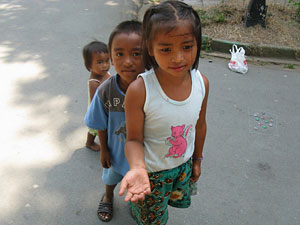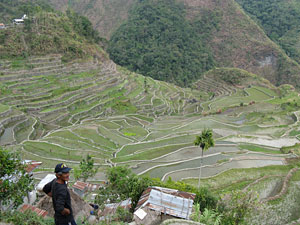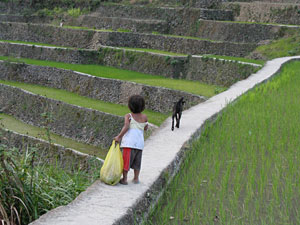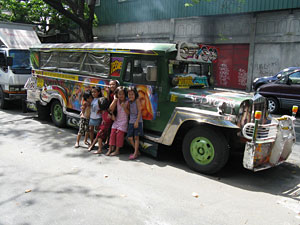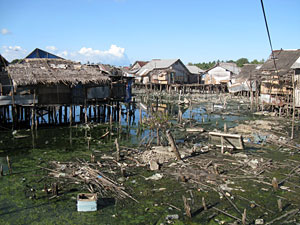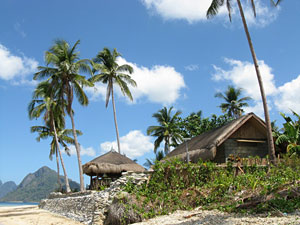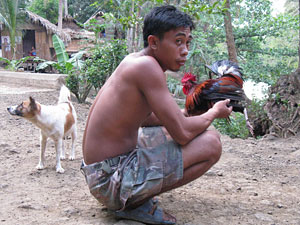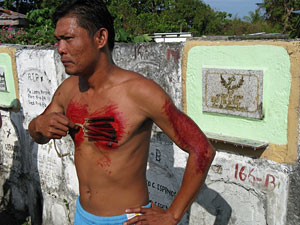Philippines
18-08-2010
February - April 2010
One night with bus to Istanbul. Flight to Bahrain. Transit queue after a whole aircraft of Bengali and another shorter night on our way to Manila. In the last years I forgot airplanes can sometimes land during the day, so the 30 hour weariness soon evaporated under the sun light. 10:30 in the morning is a perfect time to look for a hotel. We took a jeepney and it drove us for half an hour in a 4 km distance from the airport. This was our first and last free trip in the Philippines – the ATM spit out only thousand peso bills, and the fee was 14 peso for both. The jam on the 4-5 lines boulevard turn into full stop when we turned into the narrow avenue to Baclaran. Rickshaws rambled without a progress and with the crowd we submerged in the labyrinth between jeepneys, shops, stalls with mango, papaya, bananas, clothing, etc. but only spiders and flies were moving forward. The smell of fruits, mold and moisture awoke old Asian memories, and somehow in that entire deadlock after awhile came the last stop of the Metro system. It is only logical the Metro to reach a point where nobody can get anywhere, or else people will get spoiled, lose their fighting spirit and forget how to curses in their mother tongue. In Korea town we asked for a suitable place to stay, and at the end two locals of indeterminate sex seated in front of a local "Mr. Lady" helped us. In the early afternoon we moved in a decent room accessible through dark stares going to another brothel. We bought some odds and ends and napped for a few hours before going out after sunset. On the street, crowd of teen filippinas grouped according to the color of their revealing dresses gathered in front of the bars. We watched the strange ritual where they spur one another with chanting, cheers and shouts on their yet another sticky working night, while walking around with their heads up, fatty bellies and sparkling glasses the vacationing Don Juans from Europe and America were looking for their night act. The next day difference in the picture was the color of girls' garments. Apparently they were rotating them not to get bored.
I had a very sketchy plan where to go while in the Philippines, but this country has hell of a crazy geography. Islands in Indonesia are about 3 times as many, but their order is more or less logical and it is obvious how to get from Aceh to Timor. While here the islands are scattered like popcorn. Planes fly in a criss-cross, mostly from Manila, and the route of vessels becomes clear only when you get to the port from where someone has decided to send a ship to the next port. Same situation with buses. Manila is about a 15 million city and lacks a central station, each company has its own terminal and the larger ones have several. Across the province there are bus terminals, but there isn't "information desk" and ultimately it is all about luck. On top of everything big carriers had suspended their cruises to Palawan (an island 1000 km southwest). It took us a day to understand it because we were getting answers like "no tickets for this month", "cargo only" or "no schedule (?!)".To say - "our last ship to Palawan sank in December and we don't travel since" is plain lose face Asian way. After three days in Manila I was desperate - I didn't have the slightest idea not only how to get to Palawan but how to get out of the capital in general. We kept asking and at the end we found the port (they are two) and the right terminal (good that I didn't learn how many are there), and bought tickets for a week ahead. In Sampaloc - one of the hundreds areas of the city - we found a bus to Banaue rice terraces ... and got away with a relief from this monstrously huge and mostly moldy, damp megalopolis.
After a night of driving the bus stopped (more than logical) in front of the tourist misinformation in town. I had couple specific questions, but my enthusiasm wither after answers like - "it is mandatory to take a guide to the top; you must register prior with us, and the price of these rickshaws for these 10 km is around $ 10". Everywhere around the world little suckers hide behind signs "Tourist information", but nobody had lied to me so bluntly and that's in their state branch. I made a mental note of all the hostels they recommended to avoid them and quickly found another, at times less expensive room. Then I talked with local young mountaineer, whose dream was to walk the Himalayas and after my brief of Pakistan, the boy produced several ideas for a route. I had to buy from the local mafia a free map (belonging to the Department of Tourism), and this was my last pittance for them. After a few kilometers and one hour on asphalt the famous rice terraces came in sight. There is a similarity with the Dieng plateau on Java island or even in Yemen, but local uniqueness comes from the fact that terraces here are quite steep and planted with rice only. The patches in dewy green spikes stand ready for harvest, but most of the fields are still covered with slightly stubbly seedlings. I don't know who decides how much water each terrace gets, but I remember in Indonesia the mayor has the lowest land. If the water is sufficient for his plants it means he's done his job well - it's like Boyko Borisov to live on allowance for the poorest. Then we went down, crossed the river, climbed the hill across again and went back to the Banaue through the rice terraces. There were no trails other than the irrigation canals and stone dikes 30-40 cm wide. We had to keep our balance - on one side there was mud up to knees, on the other side too but of 5-10 meters lower. Going down there were rocks coming out of the dike resembling circular stairs and we had to find them to get from one level to another, sometimes the walk felt like going through a strange flat open maze. In any case - over the next few days we had thousands of opportunities to perfect our technique of movement. Back in the hostel we felt nostalgia for the Manila drums of the brothel bellow us, but soon the karaoke in the bar on the hill across us started and drunken voices raised like a pack of wolves on Celine Dion music.
I wanted to go to Amuyao peak (2700 m) and even had a topographic map of the area. But the logistics were so vague that we humbly left most of the mountain gear at the hotel. We started with little baggage and almost no food not knowing if we will decide to go up or ramble in the low. First we had to walk the 10 kilometers that cost $ 10 but after we reached the end of the town a miracle happened and the price of the rickshaw fell drastically. On the second kilometer we took a rickshaw for $ 2, afterwards the locals said the price for them was $1.5. From the intersection we walked up some more, then descend to Batad and in front of us opened the famous amphitheatrical terraces. A peasant-guide tried to sell us a program for $20/day but I decided that it is for the best if he doesn't know where we were headed. However, we talked a lot - sometimes he was confusing meters with kilometers, on my question when was the last time it rained the peasant replied instantly "December 19th". We stayed in the village, well below the tourist hotels (with their beautiful views and prices), before dusk we went to the nearby waterfall and swam there. We met an elderly woman selling Coke and beer to the tourists - it turned out she was our host at the house we settled in. Same mercantile granny asked us "will you eat chicken?" and little later a chicken in her yard squawked for one last time. After another half an hour we were offered poorly cooked chicken soup ($ 10) from which came out chicken legs with uncut claws. The dogs got the chicken leftovers, and next day we continued through more terraces. Among local hardly anyone has a fear of heights. They make their first steps on the dikes since this is the only way to get to the next house. Naturally the terraces have no railing and sometimes we had to move past 3 year old kid carrying a bag of the size of the kid itself, and all kind of people and animals. Walking on the dikes there are thousands of directions to go, once outside the perimeter of the village there is only one path. It is hard to get lost and almost no crossways to the next village. Once we found food, we decided at least to try. It became clear that we can't expect great help from the locals. Filipinos in the countryside were not very outgoing, especially with foreigners, and when there is no apparent gain. Many people did not mutter a word, and the friendliest pointed a finger in unknown direction or moo indistinctly. A compass is useless in the rice fields so we didn't bother to pull it out, and after the terraces there was only one path - of the hunters. In the jungle everything grows in abundance for a month, so the passages remain only where there is regular movement. After the last terrace we disappeared in the vegetation and climbed for few hours with no other view in sight but lianas, ferns, trees and grass. Got to a ridge at 1800 meters and in minutes we knew where we were. Went down to Pattyay - the last village before the peak - found the school where a flock of children fled screaming. Then pass other house, but the village seemed dead. An elderly woman holding a child didn't react on our gestures so we continue on a bridge over the river to another neighborhood. Pass by two bad dogs and stopped at a houses where we saw people minutes ago from the lower land. A family was having lunch in the shade of the home rised on poles, two other men appeared from somewhere, and their children looked unwell and were coughing. On laundry ropes hung baby dypers made of flour bags and several minutes passed before people manage to relax enough to chat. The silent granny's house was one of the places where we could stay, and the other one was in the last neighborhood on the hill across the river. "Do you have medicine?" was their ‘door-knob’ question, but we didn't bring anything with us except a cream.
The next day we walk the rice paddies again and charge the jungle. Sometimes the path clearly stands out, but other times only tread on slippery rocks, rotten trees and smooth, slant roots. Often they are buried in a layer of wet leaves and feet collapsed into nothingness. Branches embrace you from aside, intertwined stems propped you from bellow, you shake hands with plants leaving scars for weeks compared with that nettle is like mohair scarf. For half an hour the moisture reaches every thread of the shirt and the backpack cheerfully scrapes on a fence of chlorophyll. Up and up we go - rotten branches remain in your hand when reaching for support and feet slide on the mud, but you're grateful that it is there. It is difficult to sit even for a bite - either the backpack goes to down, or the bottle is lost in the brushes. After the rain appeared centipedes the size of a slow-worm among leeches and camouflage snakes. Everything sings in green and brown and only after hours, just below the top, vegetation lowered to meter and a half. Views opened up, and sights give strength to the heart and to the feet - even the antennas on top please the eyes. Walking in the Bulgarian mountains, even in dense fog is much nicer than what we went through this morning. We stopped for a snack with two guards that were guarding the repeaters on the top and it turned out they didn't know any other mountain in the region. Most of the poor people seldom get even 20 km away from home, and it is always work related, never recreational. We rushed down to Barlig taking the suppliers path and the route of the power line - almost like a highway, and in the evening in a modest wooden peasant room we get to know yet another variety of karaoke. "Singalong" is a version where for example "Soldier of fortune" is recorded on a restaurant keyboard and instead of Coverdale sings Filipino castrate, and the drunken pack sings along.
In time for the ferry we were back in Manila. Near the north port there is a large district named Tondo, where about a million Filipinos live on 4-5 km2. By a swampy river, on the surface of which do not swim but rather stick thousand garbages, exist huts made of cardboard or tin and a few shacks. Like tunnels between them squeeze improvised streets, and although most people here just work hard is inevitable for the crime, vice and diseases to flourish. Since we walked to the port, I decided to take a taxi the way back. At first drivers refused to turn on the counter and asked for 150 pesos. We insisted, while a passer by said that there is bad traffic jam and we better bargain for a price. The news broadcasted, however, and now we started to bargain at 150 pesos but taxi drivers wanted bills us on a counter. Eventually we found a driver from the Palawan, he told us this and that about the island and even gave some advice. He had interesting parents - his mother was a senior civil servant, and his father joined ... Moro Islamic Liberation Front (MILF). "But you're not a Muslim, what does he joined them?". It turns out that once upon a time they held the illegal logging industry in the island and many of the rebels were dying for a better pay. His father was 2 times in prison, his mother came to visit at first, but eventually they separated (divorce in the Philippines is possible after minimum of 7 years, if at all), and the children went to sojourn in Manila... starting from Tondo.
The ship didn't set off until midnight (instead of the evening), after hundreds of porters obturated the hold with cartons, bags, cages with dogs and boxes with cocks. Cocks fights are probably the most harmless vice in the Philippines and roosters travel on buses and ships to islands, villages and cities, as if constantly circulating around the country. In front of the captain's bridge earlier before was parked a concrete mixer that blocked the view ahead and below the deck were arranged hundreds of folding beds with uncertain numeration. Between them remained two paths strewn with bags, water barrels and smoking men in jerseys, and from time to time through the chaos were roving hermaphrodites, one of them wealthy enough to afford intrusive breasts. A ladder close to the stern descends to the lower hold where wading in sea water and filth you can reach the toilet, the personnel table and the kitchen. While screaming babies and unyielding women are lined up along the rails and heaps of plastic chairs, cooks clean fish, boil rice and raise glasses with merry hooch. We woke up from a cock-a-doodle-doo, around us diapers have been changed, biscuits and crackers are being distributed, sailors hand out food in dishes covered with plastic bags (no need to wash) and people playing cards - Filipinos can do everything with one hand, since the other is busy keying sms. The ceiling is low and I often bang my head, but the worst is when I have to urinate slanting because the only way to fit in the toilet is diagonally. This way we traveled a total of 50 hours, but the sail had its conveniences - our hold was airy, behind my head was a huge open space with wooden lid to cover when the light was getting strong, and the inflatable jacket was perfect for a pillow. In most other ships afterwards the windows were replaced with air conditioning and TV. Even without a hint of panic passengers were exiting the hall for nearly an hour through its two narrow doors.
The first views of Palawan were on our arrival in Coron. Limestone islands rose from the South China Sea, huge rock needles and oblong stone massifs overgrown in places otherwise bare ... and very steep, vertical shores, interrupted by white sand beaches in unreachable (without a boat) emerald lagoons - like the archipelago around Komodo or the Karst of Southern Thailand. Nature in the Philippines and Indonesia is identical in style and beauty, and vegetation and animals are similar. Sampans (indon.) and bangkas (fil.) - bamboo boat stabilizers - are exactly the same, even the transport system is somewhat comparable, but the people? - People are like two poles, despite the common prehistory. Hard to find an explanation why the Indonesian culture remained so strictly original, while Filipino is assimilated into something impersonal, known from here and there ... but nothing more. One evening we gathered with the villagers with a guitar and they sang American country. Sing something in Tagalog, we want to hear Filipino song - we said, and the next performance, even in native language sounded the same. Tagalog is a mix of Spanish, English and the local (let’s name it after King Philip II) "Filipino" and maybe 90 % of the population has Spanish names. Some of them speak English, but foreign words often have only local meaning, for example, Spanish "Seguro" (like the Bulgarian "sure") has become a word without relation to any certainty. While in Indonesia the Dutch advocate a purely commercial interests, here the natives suffer uncompromising cultural imperialism. Then Magellan came the Cross, the Catholicism, feudal injunctions and the era of the barons, and the Americans bring in public education, protestant church, basketball and lean cuisine. Monopolization of the politics, protection over markets and the railroad on which the development of the country follows today are laid out by them, but like the British colonial leftovers in India, here too the foreign system often gets stuck and the tracks just bend from the heat. Generations of islanders grow with the menial awareness of an agricultural servant and younger brother of the U.S. and even after its independence the country remains their protectorate. Sorry I did not have enough time for the Islamic part - Mindanao, but religion is certainly a crucial factor in this direction. Foreign presence in the traditionally Moslem Sulu and Basilan was limited to the extent that (shortly after the Granada finally cleared ... but again found the crescent on the other end of the world) Spanish name tagged natives moros (Moors). In WW2 Asia Moors are exempt from Japanese long before been officially released by the Americans, but even today Philippine army steps in these places only in action - again against the Moro Islamic Liberation Front (MILF).
After only a day in the overcrowded resorts El Nido (nature and needle islands are more than beautiful, with beaches under pristine rocks and dozens of dive sites - all with tasting money and false smiles) we headed south to the underground river in Sabang. Bargained a bungalow at half price, we bathed in the sunset and walked around the vicinity. An officer guided me to the tickets sale booth already closing. The plan was to get to the cave on foot the next morning, but coming out from the booth the guy said - "The path is closed, you take a boat ... and come tomorrow to buy tickets" - "How can you close a whole path and mountain?" - "Just like that ... only monkeys can go there now." I woke up early next morning to test the route. I left well before 6 and I passed the rangers check point before anybody was there. Walked for about an hour and got to a steep place with rotten steps in a process of replacement. There was new timber and tools, but I went up through the rocks and continued by the other side where the descent to the cave started. Everything was in order, I went back, had breakfast, bought the tickets and we started again. But this time the rangers were there and didn't let us pass. Park management is liable for the tourists and its actions are completely justified, but when similar scenarios play on every mountain and volcano something is wrong. Whole institution (Department of Environment and Natural Resources) deals with the coordination of guides and porters for the mountaineers, renting tents, guarding from single tourists, hiring carpenters, building huts and the most vicious idea - to humanize nature and cultivated the wild. When asked why guides are needed, they would respond that this is just for security reasons (sounds like from a politician's mouth), and on the question whether there were fatalities since guides become mandatory - they answer evasively like Asians. Several peaks during our stay were completely closed for cleaning, but not from the most important pollution - garbage can be cleaned for a week, but traces of civilization remain for generations. I have been to many dead summits and now I mostly go to places where I feel free - whatever the consequences. In Sabang we took a boat - after all the huge galleries and perfectly straight for miles tunnel of the river are unique natural creations ... but we didn't enter any other national park and only walked around the mountains without departments and waterfalls without directories. Good that they still exist.
Ship between Princess and Puerto Ilo-Ilo stopped for several hours in Cuyo island. Once we felt the solid land, we ate and went along the beach. The sand was fine and clean and the water - like a tea, calm and shallow for a hundred of meters. On the other side of the nose we walked, there were 2-3 rotten boats and muddy mangroves. There were kite-surfers, covered in neoprene, which we noticed while taking off our sweaty clothes. Teddy went into the water, while I stayed to watch the baggage because a local guy started sweeping around me very diligently. I saw in the distance a surfer approached and talked to her, then she told me the story. Everyone has heard about tsetse and sleeping sickness, developing for months, but in Cuyo and other Philippine Islands hang fly (or rather sand flea) nik-nik. Its role in the maintenance of mangrove ecosystems is definitely very powerful, but the bites are unpleasant and cause severe itching, turning into holes in the skin. In some cases, bites result in death for 30 minutes, which is a much more radical than slow sleeping sickness. It is interesting to learn all this information from a man dressed as a knight in several layers of neoprene, the head mask, goggles and even gloves while you are naked in briefs on the sand marveling the wonders of nature. Nick-Nick grows in a specific section of the 50 m and somebody decided to build a house right there ... but he stopped at the foundations.
From Ilo-Ilo we transferred to Negros with a ferry and got a bus going around the coastal road. I opened the map and I liked a small coral atoll. Pretty quickly we got the crossroad to the port of Cadiz Viejo but walked outside the bus station until prices for the rickshaws fell. After several blocks and ten miles, we saw the boats. One of them just sailed off and I asked when would be the next, but there was no response. Then I saw a sign: "National Park Lacavan - entrance $3, boat (4 person max) $15, carry in fee: food $2, beer $2, water 30 cents”. So there was a restaurant and beer and whatnot ... With the idea not to get to the hotel but the village on the atoll, we stayed close by the boats. Locals with bags climbed in for 20 cents, but nobody agreed to take us and provoke the industrialist investor, monopolist and friend of foreigners. Then a woman approached and asked which room we are taking when arriving to the atoll. We chose a room. You will like it there, you'll see - she said and called a boat over the telephone, then sat down with us. We waited for the boat ... "Can you tell us whether tourists have to pay entrance fee if they only want to go to the village?". "Well, you're rich, you are another type of people ... what country are you from?" - "We don't say, see we are different so we can't talk to you." We waited in silence, then the shuttle boat came for us, but we made a round and returned to the coastal road. In a few minutes a buss stopped. On the side of the road there was a succession of sugar cane plantations and trucks overloaded with bundles and workers. Negros till today belongs mostly to a dozen dynasties sugar cane barons, whose rise began in feudal Spanish times, and later continue with the subsidized by U.S. purchase prices for sugar. Over time, the U.S. developed a new technology, prices kept falling, the quotas disappeared and Philippine landowners sunk miserably and alone on the world market. Thousands of hired workers impoverished to a state starvation and not long after emerged the pro communist New People's Army (NPA) with a familiar ideology and goal - there are many islands to be freed! From time to time, the road crosses the rusty remnants of the narrow gauge railway, in many plantations are flocking fans of antique steam locomotives that once towed wagons with sugar cane, but today the election program of candidate President includes land reform. Which sounds a fake from an ancestral haciendero (landowner).
The election campaign is party time. In a country where there are no street signs suddenly appeared thousands of posters. The names of politicians sounded familiar: Aquino - son of two icons like Ninoy and Corazon, or Roxas - there are cities on every island of the country named after his grandfather. Election campaign stations grew in smallest of the villages, but they did not distributed programs, leaflets and snacks, but ... only music came out of speakers suitable for a national stadium all day long. Each party had a simple 30 sec song which hammered in the head with its catchy motif. In Naval there was a restaurant with good cooking next to a campaign station and 20 minutes of music seemed like a nice torture, and while serving, women were moving their lips along the song with nervous tics and uncontrollable wink. Filipinos are generally speaking literate and almost all of them can read and write, but it seemed their hearts felt music better. In addition to this small pickup trucks with megaphones wander around the markets, bus stations and shopping malls and played, and played the same catchy songs for ever. All rickshaws and buses were covered with someone's poster, but there was no doubt that the tandem Aquino-Roxas will win. And as a result of the legacy in the politics Pakistani style, most of the population could support their families mainly by finding jobs abroad. No use to work in the Philippines - said 90% of people, especially women, who have more chances in the Middle East, Europe or Hong Kong. Some marry Americans and don't look back, but most of the emigrants return, live a while with the savings - somewhat independent and like a human being - and once again take off somewhere. Great deal of men simply idle all morning, then start drinking rum, gamble on cock fights, then chop somebody with a machete after sunset, but the true load of life is carried by the millions working women, even those who work the beaver under the red lights.
Just before Easter we managed to get to Marinduque island. Found accommodation with difficulty as thousand of tourists, local and foreign, had arrived in the small town of Boac for the festivities. On Wednesday, the streets were full already with trotting children dressed as legionnaires and fatty grownups in striped tunics, armor and morions on their heads. For some unknown reason local carnival recreates the story of the one-eyed centurion Longinus who stuck his spear into Jesus, was cured and became fervent Christian. And who would believe that the ancestors of these same Filipinos that stabbed once Magellan will be performing in this similar way? On Wednesday evening, the ceremony continued with a procession in white. Some carried candles, other - icons, third pushed pistons with statues, behind them the generators reinforced the romantic ambience with the dim light of bulbs. There is a monastery uptown, so that the nuns also joined the march. Only in the next morning all dressed in mantles and gathered at the broad scene. They got queue-number and the jury began to assess the costumes. There was something familiar in the air and only after in digged my childhood memories from "outdoor cinema" - International Youth Centre Primorsko where I must have seen similar performance. Classic costumes cost of 150-200 euros and few people can afford them, but there was the "recycled legionnaire" with paper garlands, cardboard and cut cigarette "Marlboro". "Miss Roman" was also elected and in the afternoon took place the choreography contest.
We couldn't duly appreciate the theatrical play (with scenes from the Bible) in Tagalog and didn't wait for the Philippine ballet. At Good Friday, we ambush the cemetery from 6 am. Expected the selfflogging to start from here, but for long in the vicinity wander only one cow - next to a jeep with photographers from the press. After a while the first penitent appeared in briefs with freshly shaved mohawks, but he took its time before swaying the bamboo sticks. Strung to his one hand, they wipped the body and then came the master of ceremonies with a bottle of rum and set razor blades. Only when they cut the thighs, arms and chest of the martyr the blood start showing and more penitent gathered around. There were dozens beating their naked bodies, and photographers took out lenses with the length of a telescope and start snapping the event. The procedure advanced, rum was merely finished when we left the cemetery to make it on time for the next show - the Crucifixion. Back at the stadium one bandit already hung from the cross. The second bandit went in the air and Jesus was brought, slightly chubby, he had some difficulty hanging on ropes around his wrists ... Yet the carnival was performed with the same pleasure and inspiration that turns us into caribbean pirates on masquerade parties. So we should not be picky.
Continue our journey back to Luzon through Naga, Bulusan and Mayon volcanoes, where we fought for several days with overgrown paths, unfortunately not going too high. Continuing south, after Samar and Leyte we reached Biliran, but looking back I don't have strong memories or required inspiration to write about these places. Philippines were predictable, consistent, polished and as it says in the guidebook - "almost harmless". If you like convenience, population that speaks some english, air conditioned hotels, malls and entertainment - you will find it an ideal place to be. On the other hand if you look for the unknown, strange and new go straight to Indonesia. Only when you see both countries can you understand each better.
Ajoutez un commentaire


